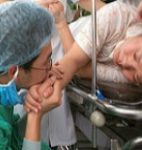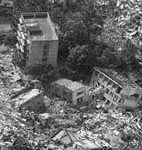Seven months after the earthquake of May 12 in Sichuan province, southwest China, the world’s attention has shifted elsewhere. But for the survivors, the advent of winter means the hardest times might only be beginning. I visited the quake-affected areas in October and saw that the government, local people and socially engaged organisations were all busily preparing for the cold weather. They face material and systemic difficulties, but everyone is working hard to try and help the situation.
Most of the survivors are now accommodated in prefabricated housing, which varies in quality but is unsuitable for the winter weather. The volunteers who sleep there say they are often woken in the night by the cold; the rooms are so damp there are puddles on the floor when they wake up. The damp and cold are hard to cope with, but the coldest period has yet to come – and this is the main worry. There is little that can be done: there is only a limited supply of electricity, and electric heating is a safety risk. People now warm themselves with fires they light outside; some have even moved back into their old brick-built homes, where they can light fires inside. Some NGOs are donating electric blankets in an attempt to help.
While those living in prefabricated homes may not have it easy, they are the luckier ones. In the badly-hit town of Yingxiu, there was an artificial shortage of housing. Shortly after the quake, the province of Guangzhou provided 1,700 prefabricated homes, more than enough for the 4,000 survivors. Yet 800 survivors remained living in tents nearby. This inequality affected the morale of the locals.
Two months later, the rows of white tents had disappeared. It first appeared like everyone had been provided with better housing, but the locals told a different story. In order to keep a promise that everyone in Yingxiu would be provided with prefabricated homes, officials had simply moved the tents and their residents into the mountains. Sure enough, I saw the tents off in the mountains: the area was not safe, with mudslides during heavy rain. Residents and relief workers wore helmets as they walked around. The temperatures up there were even lower, and it will be even worse in winter.
Besides heating, there are also the issues of providing livelihoods and water, as well as dealing with secondary disasters. The government is providing several hundred yuan a month to survivors, but what happens when that stops in several months time? The local economy has been ruined and there are few job opportunities. Many have nothing to do and simply stroll around all day. The young can leave to find work, but the poor economic outlook means even that isn’t easy. There are water shortages, with both clean mountain water and purification equipment in short supply. Landslides and aftershocks are common, making it dangerous to travel.
Fighting to survive
Despite poor or even terrible conditions, life stubbornly goes on. The biggest issue is making a living. With few jobs available, and relief funds not a long-term solution, people are trying everything they can.
On a road not far from Yingxiu, I found an old woman digging up a roadside embankment. Planting crops now means she can harvest them in a few months. Almost every bit of spare land has been used to plant peanuts, cabbage or potatoes. Hopes of better lives are starting to sprout.
There are few ideas beyond planting crops. Middle-aged women chat and knit outside their doors. Having nothing to do after the quake, many picked up their knitting needles and sewing kits in order to earn a little extra cash. The Tibetan women join in too, even though they are not traditionally skilled in those crafts. One 94-year-old woman, who was rescued five days after the quake, works non-stop making embroidered insoles – not to sell, but as gifts for her rescuers. When I met her she was sitting outside working and told excitedly about her rescue. She had finished over a dozen pairs of insoles, she said, and was about to send them to Shenzhen, Guangdong province, the home of her rescuers.
There is no great demand for these products. The local women do not make many different styles of embroidery, but it is one of the few things they can do. A number of socially engaged organisations are running similar projects, organising local women into embroidery groups. One project, run by a strong young woman who lost two children and her home in the quake, uses pictures drawn by local children as the basis for the designs.
It is comforting that people in quake-hit areas are becoming more autonomous. In some areas they are working to solve issues themselves, as well as relying on the government.
Longmen Baoshan was the site of a state-owned mine that closed in 2002. The several thousand residents who remained are mainly the elderly, women and children. Men of working age left to find employment. Here, four voluntary organisations have jointly launched a “new home” plan to help the locals rebuild their community. A tent has been erected in the yard of an abandoned school, where people gather to watch television, chat and drink tea. Chatting and gossiping have always been a major part of Sichuanese culture. Childminding, educational services and drinking water are also provided here, all at no cost. These activities have given the residents a sense of community and peace-of-mind.
The decision-making process for public services has shown a deep level of community autonomy. There was a shortage of drinking water after the quake, so a firm from Foshan, Guangdong province, donated purification equipment. Before it went into operation, however, relief workers organised a meeting where the locals could use simple, democratic methods to decide how and when the water would be available. They were able to take their and the volunteers’ needs into account, making sure that things were timetabled correctly. Eventually it was decided that water would be available between 10 and 11 in the morning, and 4 and 5 in the afternoon. Encouraging the residents to discuss communal issues was an important way to increase the community’s ability to self-govern.
Two months later, community democracy has taken shape. At a recent meeting to discuss the running of two water heaters at a communal shower block, the number of attendees was several times higher than previously. The atmosphere was lively and friendly, and the meeting was efficient. The community now has significant experience of managing itself, which will be necessary as they face the winter.
The local government has also made improvements by becoming more flexible. The “new home” scheme benefited from the support and participation of the local environment authorities. In the town of Hanwang, the government is working with NGOs to develop community self-governance. There are plans for a 1,000-square-metre community centre. There is unprecedented government support for civil society, with no interference in internal NGO matters or attempts to make NGOs subordinate to government. The government, NGOs and locals working together could be the ideal model in order to make it through the long winter – and for the entire process of reconstruction.
Tang Hao, born in 1974, is a newspaper columnist, deputy editor of Shimin (Citizen) magazine, and assistant professor of politics at Huanan Normal University. His essays and opinion pieces have appeared in Contemporary International Relations, International Studies, Nanfang Daily, Yangcheng Evening News, Southern Window and many other publications.
Homepage photo by thenez




